Christian Vuissa
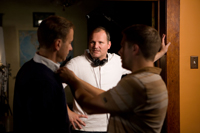
Could you tell us about your background?
I am from Bregenz, a small city in Austria that has about 30,000 citizens. Bregenz is the capital of the most western state of Austria which borders Switzerland, Germany, and Liechtenstein. The city is known for its Open Air Opera Festival, an annual summer festival held on a large stage in the middle of a lake (featured in the latest James Bond movie). A big difference between Bregenz and Utah is the proximity of different cultures. In Bregenz, for example, if I drove for a few hours in different directions I would end up in several different countries with different cultures, food and languages. I could be in Switzerland and Germany within ten minutes and France and Italy within four hours. When I was a kid you had to cross the border with a passport. Now, it is all part of the European Union. Growing up, entertainment in Bregenz was in a sense very diverse as well. There was a mix of films from neighboring countries along with kid’s movies from Czechoslovakia and many films from the United States.
I was baptized into the Catholic faith soon after I was born, but my mother converted to the LDS Church when I was about seven. My father never joined the Church, so I basically grew up in both faiths, attending Catholic classes in school and going to a small LDS branch on Sundays. I became serious about religion in my early twenties and had a very strong conversion experience that led me to joining the Church when I was 22, leaving on a mission when I was 24, and coming to Utah when I was 27.
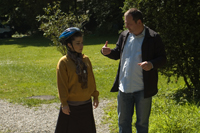
How has your background influenced your work?
When working on The Errand of Angels I was immediately drawn to the conflict between Sister Taylor and Sister Keller. We often label people as good or bad without really seeing their heart or understanding anything about them. I like stories that offer a different perspective, an angle that helps us comprehend the world from a different point of view. As a filmmaker I try to offer that perspective on the “other side” or the often ignored or misunderstood person. My mother always taught me to reach out to outsiders in any given group or environment. I think this type of upbringing has influenced my work.
How did you get started with film?
I had a few film experiences in high school and was drawn to writing a script when I was sixteen, but it never really materialized. I took a screenwriting course a few years later and worked for a video production company for a couple of years. But it wasn’t until I got into the film program at BYU that I seriously considered filmmaking as a career.
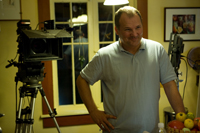
Why Mormon cinema?
One of the greatest things about BYU is its International Cinema program. It was mainly established and run for Humanities students to offer insights into the world of other cultures. I think there is a huge void of such films about Mormon culture and heritage. A unique quality about film is that you can tell stories that make it possible for the viewer to enter a world they are not familiar with. After only two hours of watching a film onscreen, it is possible for us to not only understand but also have compassion for another culture, its rituals and traditions. Additionally, these same films have a similar effect on those already familiar with that culture. They see their own experience reflected on the screen and can draw inspiration, motivation, and meaning from it.
In the global world we live in today, where much of the entertainment and pop culture comes out of Hollywood, small countries like Austria struggle to remain and uphold a certain national identity. This is why films are mostly funded by governments, because there is a desire to preserve a national identity. There is even a special label for films that accomplish that—“culturally precious.” I think the same is needed for the Mormon culture. Even though there are members all over the world, our faith unites us much like a nationality. At the same time, we are also heavily influenced by the culture that surrounds us geographically. I remember a Swiss journalist who visited the BYU campus during the 2002 Olympics saying that he didn’t find it any different here than anywhere else in the United States, and he did not mean it as a compliment. What struck me was that we ourselves might lose sight of what makes us unique and different. There is always a desire to fit in, but at the same time we need to reflect on what is “culturally precious” within our own culture and try to preserve our unique identity. I think film is a powerful medium that does that.
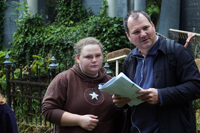
What motivates you to produce work that has a very particular and small target audience?
You have to have an audience you love and care about to create something of value. That can be one particular person or a group of people. I do not think the LDS audience is a particularly small audience. It is a bigger audience than if I were to make films in Austria, for example, which has a population of 8 million people. The only problem is that film is expensive and that is why the government pays for it pretty much everywhere outside of the United States. Not many films would be made without that support. In our LDS environment we still rely on the financial success of a film. That is why we have seen a decrease in LDS-themed films in recent years. We still need to establish a structure within our community that allows filmmakers to grow and contribute while at the same time being able to make a living. Right now there is no such support structure in place. I hope that with the LDS Film Festival and my production model at Mirror Films we can inspire some people to change that.
Films have tremendous potential to tell our stories to ourselves and to the world. But I also see potential in the limitations. For example, I produced both The Errand of Angels and Father in Israel for less than $200,000 each in order to have a decent expectation of return for our investors. That means I have 1 penny for every 3 dollars Hollywood spends on average on a feature film. If I spend $1, Hollywood spends $300. You can’t compete with that.
But that is exactly where I also see potential. If we look at our limitations and think about how we can creatively use these limitations to our advantage, we can create something entirely new. But I think it has to be done with the audience in mind. If we try to imitate Hollywood, we can only lose, because they will always have more resources available. But if we find those things that money can’t buy, things Hollywood can’t duplicate, we can offer our audience an experience they have not previously known.
How do you see your work building the kingdom?
I currently see my films working on “perfecting the Saints” in terms of the three-fold mission of the Church. But with each project I will probably expand to make films that “proclaim the Gospel.” The role of feature film narratives in building the kingdom is hugely underestimated at this point. If it weren’t, a lot more money would be made available to do so.
In what direction do you see Mormon cinema going?
Mormon cinema has lost its steam in recent years and we will have to see what happens. I think there were a number of extremes in the beginning, from the goofy comedy to the heavy drama. But in the end there will probably be a balance somewhere in the middle. I also think that there was a strong urge to tell Hollywood-type epic stories, which basically wasted millions of dollars that could have been used to build a more modest but consistent independent film movement. I believe that “by small means the Lord can bring about great things.” I hope we can find a way to apply that principle to filmmaking. The opportunity we have right now is to establish a film form that is unique to our culture.
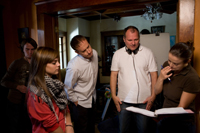
What is your favorite role in the filmmaking process? Why?
I like all the different roles, but in pre-production I enjoy finding the right actors for the film and scouting locations. Framing the picture, directing the actors, and blocking a scene are all very enjoyable during production, and editing the film in post-production is rewarding because everything is finally coming together. Throughout, I enjoy the collaborative aspect of filmmaking, having the opportunity to work with other creative people.
Tell us the story behind The Errand of Angels.
Heidi Johnson, the producer and initiator of the film wanted her mission experience told in a film. Through my mission president, Terry Johnson, her father-in-law, she made contact with me and began asking questions about making a film about sister missionaries. She was determined to make this film a reality, and I was impressed with her perseverance. The story is based on Heidi’s mission but we took many liberties in telling Sister Taylor’s story. Many of my own mission experiences flowed into the story but the film really is a tribute to sister missionaries and missionaries in general.
What is your favorite scene in that film?
I have two favorites, the first being the scene in the old Jewish cemetery. I like how Sister Taylor’s prayer is being answered without her really knowing it. God works with us and leads us in ways we often do not understand. The cemetery scene signifies that only when looking back do we realize that God has guided us along the way. I also like the scene when Sister Taylor looks through Sister Young’s scriptures and finds pictures of Sister Keller and Sister Young. This process of discovery continues later on in the train back to Vienna. By seeing pictures of a “different” Sister Keller, Sister Taylor is able to take responsibility for her own relationship with Sister Keller without blaming all of her struggles on her companion.
What were some of the miracles you saw while filming it?
We had miracles happening constantly. From how we found the actress to play Sister Keller, to how we were able to film this 600-year-old house that served as the sisters’ apartment in Salzburg. Also, we were not kicked out of train stations, trains, streetcars, buses, or any public places until after we got our coverage. And we were able to finish production on time. I think small miracles happened all along the way.
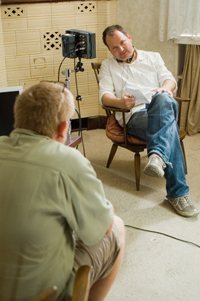
Tell us about founding the LDS Film Festival.
I started the LDS Film Festival when I was still a film student at BYU in 2001. I was impressed with the talent of many of my peers in the film program along with other filmmakers I met here in Utah, and I thought it would be beneficial to the community to establish a festival that offered a venue for filmmakers to showcase their work. The whole LDS cinema genre was barely established at this point, but there was a certain confidence in the air that did not exist before. When I started the festival there were hardly any feature-length films being produced by LDS directors or producers. But I had a strong feeling that this would change over time and that at some point the LDS Film Festival would premiere dozens of feature films made by LDS filmmakers. Two years later, we began to screen feature films at the festival. Since 2006 we have had about a dozen feature-length films in the program every year. We have truly seen tremendous growth.
What are some of the success stories that have occurred as a result of the festival?
Over the years we have become a key player and motivator in the LDS film community, signaling progress when many thought the LDS film movement was dying. In general, as a festival we are able to present what will happen in the LDS film world over the course of the year. Attendees at the festival are well-informed about most upcoming developments and film releases by LDS filmmakers. Additionally, we have helped create buzz for films before they were released in theaters, therefore creating awareness early on. Examples of this include the films Saints and Soldiers and The Best Two Years. Last year alone we premiered five or six films at the festival that ended up being released in theaters in 2008. We also have seen winners and honorees of the short film competition move on to do bigger and better things. For example, Jared Hess had a number of short films in the festival before directing Napoleon Dynamite. He was also in the group that won the first 24-Hour Filmmaking Marathon. The marathon was started in 2002 and is a fun competition where groups of five people create a film in 24 hours. A year later, in 2004 (the festival switched the festival dates from November to January, basically skipping 2003), Mark Hedengren, who had never previously made a film, participated in the marathon and won first place. His film ended up playing at festivals nationwide, which won him awards and grants. The 24-Hour Filmmaking Marathon draws about 40 to 50 groups each year and motivates amateurs and professionals, high-school kids and college students, to make movies.
Based on the success of the marathon, we started the 7-Page Script Competition in 2007, where writers submit their scripts to the festival and the festival selects three young filmmakers to read through all the scripts. One is then selected and made into a short film. The festival gives the filmmaker a budget of $500 and assists in the production of the film. Similar to the marathon, we have seen tremendous success with this initiative, having now produced nine short films that have won awards at festivals both nationally and internationally.
The LDS Film Festival has grown steadily over the years. The first festival had an attendance of about 750. Last year we had over 6,500 people show up. What began as a short film festival is now a full-blown festival that offers a variety of different formats, genres, and styles. This year alone we have about 40 feature films and special screenings. In the last three years we have also established ourselves as a festival that is packed with filmmakers who come to network, socialize, and simply enjoy the films.
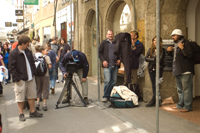
Where do you see the LDS Film Festival going in the future?
We will continue with what we are already doing while hoping to increase the attendance and quality of the program every year. We want to become one of the major events in Utah County, eventually attracting tens of thousands of people. To reach this goal, the LDS film community needs to continue to flourish, and so far we still see a lot happening. Additionally, we will increase our involvement with the filmmaking aspect of the festival, like the 24-Hour Filmmaking Marathon and 7-Page Script Competition, with the goal to eventually produce feature-length films that are marketed to both the LDS and general audiences. And we would also like to get more involved in training and education, helping young filmmakers to grow and succeed. We want to be the place where new talent is discovered early on, a place that offers young filmmakers a head start. Finally, we want to become the biggest festival in the region that not only attracts a huge audience but also numerous distributors and industry professionals looking for product and talent.
What do you hope will be accomplished with all of your efforts?
I hope the festival helps our little film community to be united and succeed. We can all learn from and influence each other. I believe that it is important that we come together to appreciate each other and the little things everyone contributes. Every filmmaker is stronger if the whole community thrives, and vice versa. The success of one is beneficial to the progress of another. We need to understand that appreciating our diversity fosters our unity. Each year the LDS Film Festival tries to bring the community together to do just that. The wonderful thing about the LDS Film Festival is that people can really mingle and network. Established filmmakers come to the festival and willingly share their experience and knowledge. Audiences also have the rare opportunity to meet filmmakers and learn from them. I am astonished at how much goodwill exists within this community and I see it every year at the festival. One weekend at the festival can be more informative and inspiring than a whole semester at film school. People always leave the festival motivated and hopeful.
In regards to my own filmmaking efforts, I really hope that I can grow into a filmmaker who makes films that not only entertain but also edify. I really think that films have the potential to “instruct in such a way as to improve, enlighten, or uplift morally, spiritually, or intellectually” by telling stories that resonate deeply within us and inspire us to reach our full potential. I consider myself a beginner at my craft. But hopefully I will have the opportunity to grow as a filmmaker with each film that I am involved with. ❧
